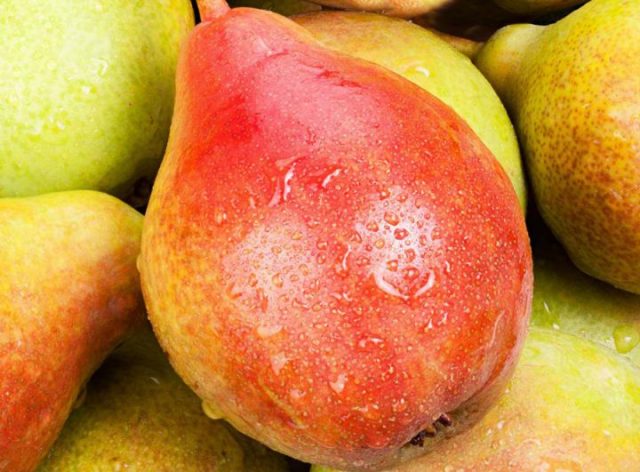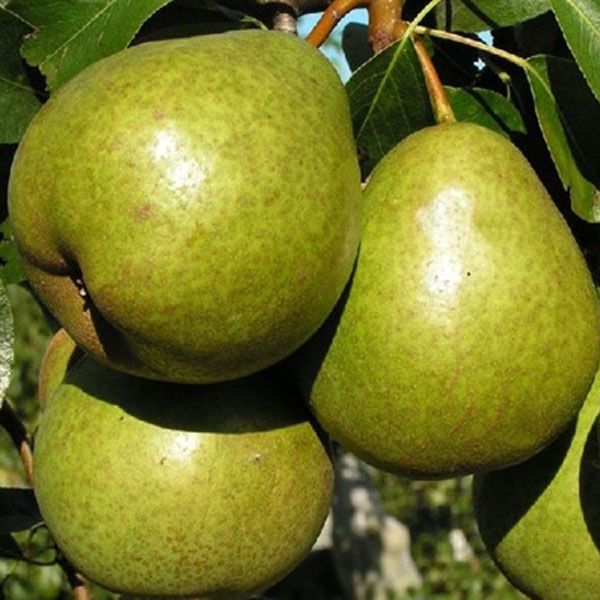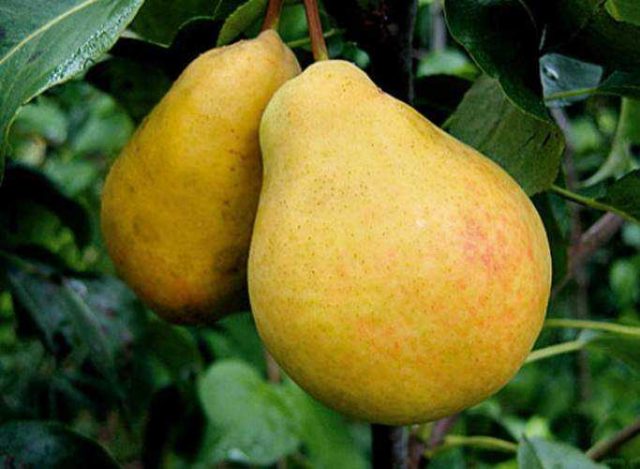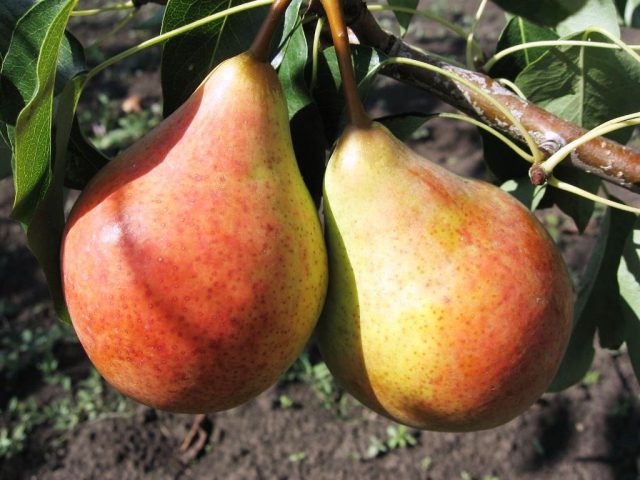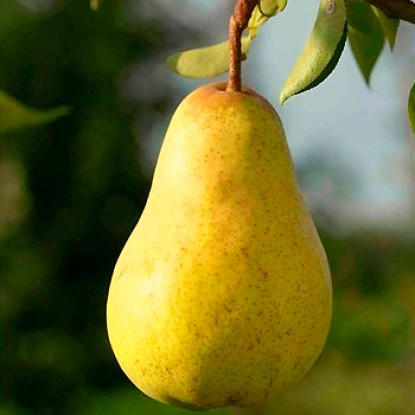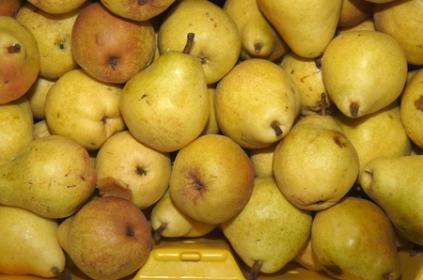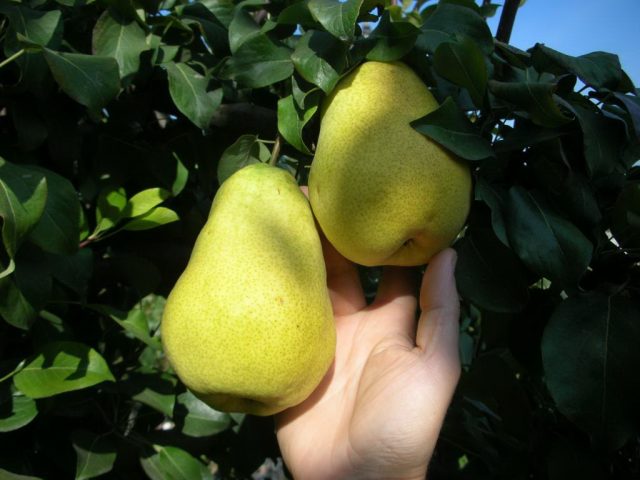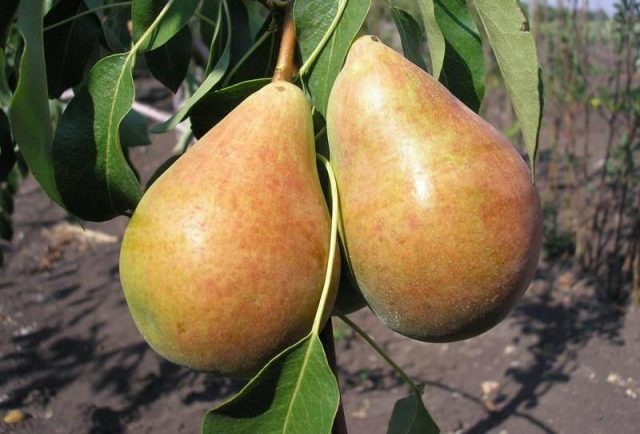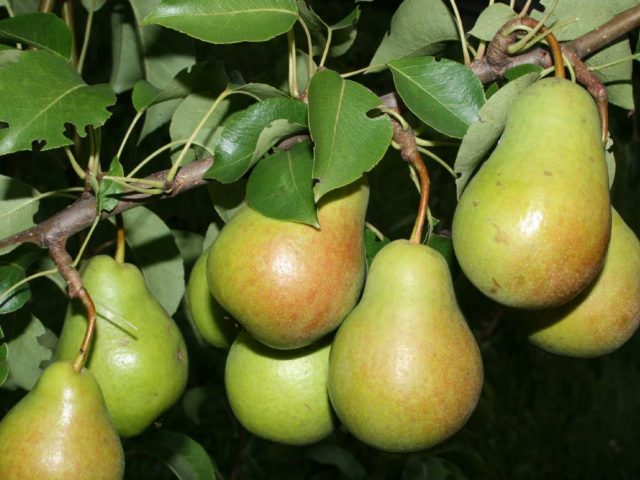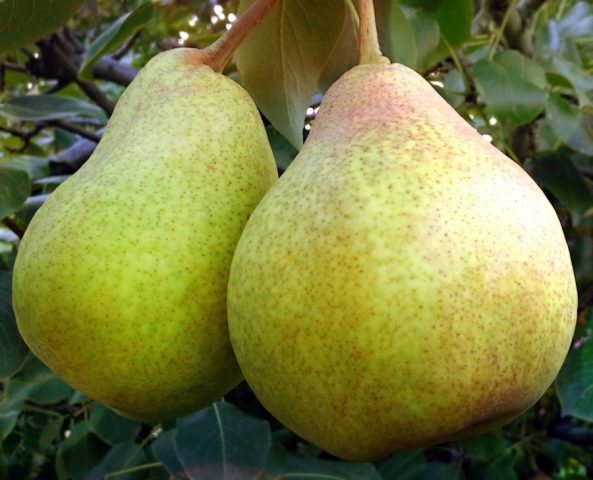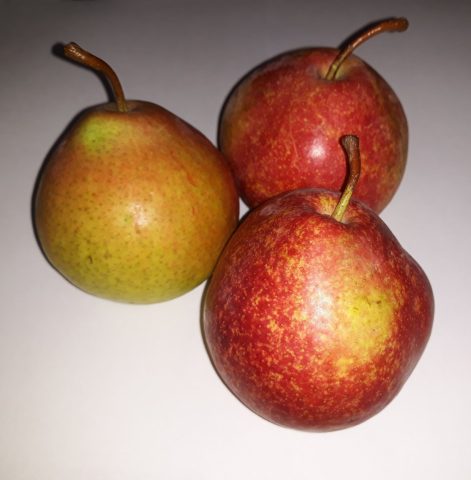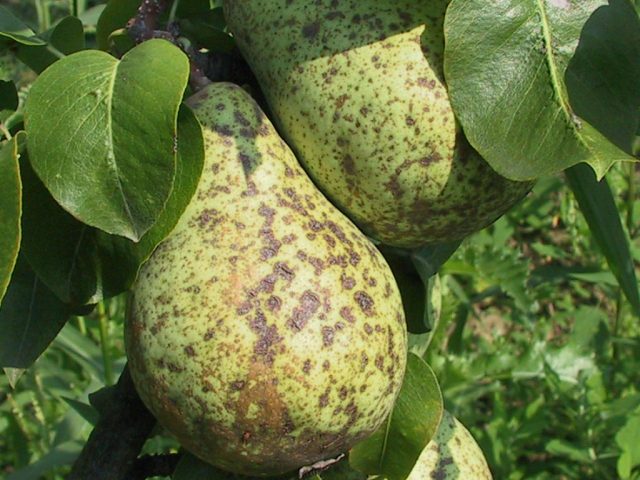Content
- 1 Description of pear variety Bere
- 2 Views
- 2.1 Pear Bere Ardanpon
- 2.2 Pear Bere Gardi
- 2.3 Pear Bere Yellow
- 2.4 Pear Bere Giffard
- 2.5 Pear Bere Gold
- 2.6 Pear Bere Clergeau
- 2.7 Pear Bere Krasnokutskaya
- 2.8 Pear Bere Crimean
- 2.9 Pear Bere Liger
- 2.10 Pear Bere Loshitskaya
- 2.11 Pear Bere Luca
- 2.12 Pear Bere Maria
- 2.13 Pear Bere Oily
- 2.14 Pear Bere winter Michurina
- 2.15 Pear Bere Morettini
- 2.16 Pear Bere Moskovskaya
- 2.17 Pear Bere Royal
- 2.18 Pear Bere Russian
- 3 Planting and caring for pears Bere
- 4 Diseases and pests
- 5 Testimonials
- 6 Conclusion
Description, photo and reviews about pear Bere Clergeau will provide more information about the subspecies. The Bere group itself became famous in 1811. She comes from France or Belgium. Translated from French, the name means "butter". Indeed, the peculiarity of the variety is the pulp with a delicate and at the same time soft consistency. In 1947, state tests of culture and world recognition began.
Countries where the Bere group is distributed: Russia, Ukraine, Belarus, Armenia, Moldova, Georgia, the states of Central Asia.
Description of pear variety Bere
The main varietal features of the Bere group:
- The height of the tree is about 4 m. The shape of the crown is in the form of a pyramid, spreading, eventually becomes asymmetrical.
- Young shoots are of medium thickness, gray-green in color.
- The foliage is oval, large. The ends are pointed.
- The length of the petiole is 0.8-1.5 cm. The buds are compressed.
- Inflorescences are white, large, wide. The petals are oval.
- The plant blooms in May.
- Fruits are large and medium-sized. Their length is 8-10 cm.Weight is 180-230 g.
- The shape is standard pear-shaped, oval.
- The skin is predominantly green or yellow, depending on the stage of ripening.
- The taste is sweet, sweet and sour, with a spicy aroma of nutmeg.
- Fruit ripening period September-October.
- The fruits are able to hang on the tree for a long time without losing their taste.
- Low frost resistance. The climatic zone of the Crimea and Krasnodar Territory does not always suit the culture.
- The yield is high. The appearance of fruits on the tree begins 3-7 years after planting.
- Disease resistance is high, but preventive treatments are required.
- Bere pears are partially self-fertile plants, therefore, it is recommended to plant next to pollinators to increase the yield.
- Life expectancy of Bere pears is 50 years or more.
Views
Pears Bere has more than a dozen varieties. And they all differ in characteristic features: ripening period, visual appearance, early maturity, resistance to frost and ailments. The following are the most famous and popular varieties.
Pear Bere Ardanpon
The pear belongs to the winter varieties. It was bred in Belgium in the 18th century. The plant received the name of its discoverer of the same name. Tall tree. The crown is dense, pyramidal in shape. Fruits are large, bell-shaped pear-shaped with irregularities. Weight 200-250 g. The pulp is white, sweet, astringency is felt. The amount of sugar is 10.2%. The skin is light yellow, green with brown splashes. Fruits differ in keeping quality, they are stored for up to 4 months without loss of taste. The description clearly states that the Bere Ardanpon pear variety can be grown exclusively in warm regions. It bears fruit well in the territory of Southern Crimea. The species is prone to scab.
Pear Bere Gardi
The Bere pear variety is of French origin. The tree is tall and strong. The crown is cone-shaped, widened towards the apex, strongly branched. Branches growing horizontally, hanging down. Fruit weight 150-200 g. The pulp is creamy, juicy, sweet-sour, with a noticeable spicy aroma.The peel is dense, dry, yellow in color with brown or red spots on the sunny side.
Pear Bere Gardi is undemanding to planting conditions. Fruiting occurs in September.
Pear Bere Yellow
A hybrid of Russian origin, adapted for the conditions of the northern regions. Found in horticultural catalogs under the name "Berezhenaya". The trees are low to medium-sized. The crown is round. The foliage is light green, the surface is matte, the edges are serrated. Small flowers are collected in inflorescences. Fruit weight 100 g. The shape of the pears is correct, the surface is smooth. The skin color is light yellow, there is no blush. The pulp has a delicate texture. Lots of juice. The seeds are large, dark in color. The fruit tastes sweet and sour. The sugar content in the pulp is 11.2%. Transportability is good. Fruits ripen at the end of September.
Pear Bere Giffard
This variety appeared in France in 1810 from seeds of unknown origin. The tree is up to 5 m high. As the tree matures, growth slows down, but the yield and winter hardiness indicators increase.
The branches are thin, reddish in color. The leaves are large, light green in color. When ripe, the fruits form the correct shape. The surface is smooth with brown blotches. The pulp is juicy, melting in the mouth, sweet with sourness. Pears ripen at the end of September. Low fruiting. Fruit weight 50-100 g. Stored ripe for 3-5 days. Afraid of frost. Pear Bere Giffard is resistant to fungal diseases.
Pear Bere Gold
Pear Bere Gold belongs to the summer varieties from the national selection of Belarus. The height of the trees reaches 3 m. The crown is very thickened, therefore it requires regular thinning pruning. Fruiting of Bere Gold Pears occurs at the age of 5-6 years. Fruits ripen in August. The yield is abundant. After ripening, pears can persist for 7-10 days. The variety is highly resistant to bacterial cancer and scab.
Pear Bere Clergeau
Pear Bere Clergeau came to Russia from Western Europe. The variety is called the originator. A tree of medium height with a narrow pyramidal crown. The leaves are small, narrowed to the tip. The fruits are dense, with a pleasant taste and aroma. Fruits ripen in early September. Tear off immediately, otherwise they crumble and lose their taste. The Bere Clergeau pear begins to bear fruit at the age of 4-5 years. In cold regions, the tree requires shelter.
Pear Bere Krasnokutskaya
The fruit tree is of medium height. Forms a conical, rounded shape. With regular pruning, annual growths are removed. Large pears, weighing 200-250 g. Fruit shape is elongated, green-yellow in color with brown tint. The pulp is oily, yellow, juicy. Taste sweet and sour, pleasant delicate aroma. Tasting score - 4.5 points.
The first fruits appear after 5 years. After another such period of time, up to 50 kg of harvest can be obtained from the tree. And at the age of 15 years - 120 kg. The ripening period of Bere Krasnokutskaya pears is September-October.
Pear Bere Crimean
In 1964, a group of breeders obtained the Crimean pear variety by free pollination of the French variety Bere Bosc. The trees are medium-sized, the crown is pyramidal, not thickened. The fruits grow large. They can reach 520 g, average weight - 340 g. The surface is bumpy, there is a slight ribbing. The shape of the fruit is short pear-shaped. The main color is green-yellow; when ripe, an orange tint appears. The stalks are short. The pulp is creamy, tender, sweet. The ripeness of Bere Krymskaya pears is the second half of September. It is characterized by frost resistance, high immunity, stable yield. Flowers are not afraid of spring frosts.
Pear Bere Liger
The origin of this versatile variety is unknown. Presumably it was bred in 1782 in the Czech Republic. The tree is large, usually growing to the sides. The shape of the fruit is round or ovoid.The surface is flat, without bumps and ribs. The pulp is juicy, tasty, with a light nutmeg aroma. The skin is thin. The color of ripe pears is light green. After a while, it turns yellow. Fruit weight 120-160 g. Pears ripen in September.
Pear Bere Loshitskaya
By the age of 5, the tree begins to produce a stable harvest, and at the age of 10, 40-50 kg of fruit can be harvested. Fruits are broad, pear-shaped, about the same size. Weight 70-100 g. The pulp is semi-oily, juicy, pleasant to the taste. The color of the pear is pale green, when fully ripe it is light yellow. The fruit is removed from the pear in the second half of September. Can be stored for up to two weeks. Pear Bere Loshitskaya is moderately resistant to diseases and has high indicators of frost resistance.
Pear Bere Luca
Late ripening variety bred in France. Growing fast. Crohn of medium density. The tree is resistant to scab and septoria. Average winter hardiness. Fruits are small, weight up to 200 g. The skin is thin, green or yellow. Ripening period falls on November. It can be stored for up to 3 months. High transportability. Pear Bere Luka variety is suitable for dense plantings. The gardeners' reviews describe the distinctive features of the Bere Luka pear: the wavy surface of the foliage, the presence of thorns, large fruits that cannot be seen in the photo.
Pear Bere Maria
This is a variety of autumn fruiting, which occurs in a culture 3 years after planting. Medium height tree. The crown is pyramidal. The density is average. Fruits are medium in size, cone-shaped. The skin is thin, dry, tender. The color of the peel of the Bere Maria pear is yellow-green with dotted patches. During ripening, the color of the fruit becomes monotonous golden. The pulp is fine-grained, white, sweet, with a lot of juice. Productivity from one tree is 40 kg. The variety is characterized by high frost resistance and immunity.
Pear Bere Oily
The tree was obtained in the 18th century. In France. It has long been cultivated in the Crimea. Pear Bere Oily is characterized by active, asymmetric growth. The crown has a highly pyramidal shape, consisting of several strong shoots. On good soils, the crown thickens. The fruits are elongated. Usually fruits are of medium size, but there are specimens up to 500 g. The stem is long, arched, gray colored. The skin is firm but thin. The color of the unripe fruit is green, the ripe fruit is yellow-gold. The pulp is tender, juicy, sweet enough, with excellent taste. It tolerates transportation and storage well. Pear Bere Oily ripens in September, but sometimes it is deliberately overexposed and removed a month later. Thus, the fruits reach their maximum volume and sweetness.
Pear Bere winter Michurina
The species was bred by Michurin, the varieties Ussuriiskaya Dikaya and Bere Royal became the parents of the species. At the moment, the Bere winter Michurina pear has lost its relevance for production and personal purposes due to more productive competitors.
The tree is large and powerful. The crown is branched, pyramidal, wide. The foliage is oval in shape with pointed ends, light green in color. Fruits are medium-sized, asymmetrical in shape. The surface is slightly rough, matt. The description indicates the color of the ripe pear Winter Bere Michurin as pale green, however, according to reviews and photos of consumers, a yellow tint is obtained with prolonged storage. The mass of the fruit is 100 g. The pulp is white, sweet and sour, with hardly noticeable astringency. The sugar content is 10%. The variety is not prone to scab.
Pear Bere Morettini
The variety was created in Italy. In Russia, it is zoned in the territory of the North Caucasus. Medium sized tree. The crown is pyramidal. The branches extend from the trunk at an angle of 40 °. Shoots are straight, weakly genital. Shoot-forming ability is average. The bark on the trunk is gray, and on the shoots with a greenish tint. The fruit is slightly wider than the standard pear shape. The skin is thin, slightly oily to the touch, shiny. When the fruit is fully ripe, the color becomes light yellow with a pink blush.The peduncle is of medium length. The pulp is light, tender, sweet, juicy. The amount of sugars is 11%. Fruiting occurs in July-August. The disadvantage is weak drought resistance.
Pear Bere Moskovskaya
This variety is the result of selection of trees with summer and autumn ripening. The early-growing variety begins to bear fruit as early as 3 years after planting. Fruits ripen on short, ringed branches. The harvest, which has not been harvested on time, is overripe and sprinkled. The Bere Moskovskaya pear is suitable for universal use, and it is also resistant to diseases, frost, and stress.
Pear Bere Royal
Another variety of Italian selection. The tree is practically not grown in Russia, since it has weak indicators of frost resistance. It just freezes in the Russian climate. Crohn of medium thickening. The flowers are white. Fruits are large in size, yellow in color. They can be stored until spring. Disadvantages: needs special growing conditions, lack of immunity to scab.
Pear Bere Russian
Fruit culture belongs to the autumn-winter varieties. The tree reaches a height of 4 m. The crown is wide, highly branched. The color of the bark is gray. Inflorescences are collected in an umbrella-shaped raceme. From the photo, of course, this cannot be confirmed, but in the description of the pear variety Bere Russkaya it is stated about excellent tasting properties, with which the gardeners agree in the reviews. The skin is thick, dense, rough. Fruits are suitable for long-term storage and transportation.
Planting and caring for pears Bere
Compliance with agrotechnical measures is a guarantee of health and abundant fruiting of fruit trees.
Crops grow well in light, loose, fertile soils with an acidity level of 5.7-6 pH. Chernozems, gray forest soils with loamy subsoil are optimal. In excessively depleted and heavy clay substrates, the pear will not take root. Despite the love for moisture, it is necessary to plant a crop in areas where groundwater is below 2 m.
Bere pears do not tolerate transplants well, so they deliberately choose a suitable site. First of all, it must correspond to the dimensions of the tree and be well lit. It is desirable that the place is oriented to the west or southwest.
Planting of seedlings in the garden is carried out in spring or autumn, or rather in October, after the foliage has fallen, in March - before bud break. A few weeks before the procedure, the earth is dug up, adding humus, sand, peat, mineral fertilizers. The size of the pit for Bere pears is 0.8x0.8 m and a depth of 1 m. Dimensions are taken with a margin for better growth of the root system. At the end of the event, the seedling is watered abundantly. The near-stem circle is covered with a layer of mulch, which will keep moisture in the ground. The distance between trees should be kept up to 4 m, and between rows 4-5 m.
In the future, Bere pears need careful, regular care:
- Seedlings do not need frequent watering. Enough 4-5 water procedures per season. If the summer is too dry, then the amount of watering should be increased. Calculate the volume of water based on the norm of 30 liters per 1 sq. m.
- The number of dressings to be carried out is chosen based on the age of the tree. A young plant needs feeding especially on poor soils. In the spring, nitrogen nitrate is introduced to enhance the growth of a seedling 20 g per 1 sq. m. Organic fertilizers are given once every 3 years.
- Crown formation begins after two years of age. The main 3-4 shoots, equidistant from each other, are subject to pruning. Shorten them by ¼. The trunk is made 30 cm higher than the rest of the branches. Every spring, sanitary pruning is carried out.
- Bere pears do not have high frost resistance, so there is a need for winter shelter. The trunk and shoots are wrapped with agrofibre, which will help to endure severe frosts.
Diseases and pests
In the pear garden, Bere can get sick with the following ailments: rust, mosaic disease, scab, fruit rot, fire blight, subcutaneous viral spot, black cancer, sooty fungus and cytosporosis.
Fungal infections are treatable. Fungicides are considered effective agents, in particular Bordeaux liquid, copper sulfate, Fundazol. After diagnosing the symptoms, it is necessary to immediately spray the branches, leaves, flowers with a solution of a chemical preparation. As for bacterial diseases, the situation is more complicated with them. Antibiotic treatment can be given. If there is no improvement, then the affected parts of the tree will have to be removed and burned. In extreme cases, the culture is completely uprooted.
The main insect pests of fruit trees are the subcrustal leafworm, honeydew, gall mite, moth, and aphid. You need to fight these and other possible parasites with insecticides or more gentle folk remedies.
Despite the many treatment options for a poor condition, prevention is by far the fundamental rule of tree care. These measures involve: timely pruning of dry, sick, broken shoots, harvesting fallen leaves, removing weeds near pears, loosening the soil, whitewashing trunks with lime, regular spraying with special preparations in order to prevent pathogenic microflora and parasitic organisms.
Testimonials
Conclusion
Description, photos and reviews about the pear Bere Clergeau will be useful when choosing a fruit crop. After all, it is she who is the most demanded variety. Although each variety has its own individual traits and characteristics that must be reckoned with. The soil composition and climatic conditions of the area should also be taken into account.
